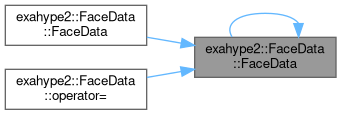|
Peano
|
|
Peano
|
Represents the sides of one face, with 2 sides (left and right) to a face For ADER QIn will contain the values, QOut would contain the fluxes QIn[faceId][0][...] will contain the values of the left side relative to the face QIn[faceId][1][...] will contain the values of the right side relative to the face. More...
#include <LRFaceData.h>
Public Member Functions | |
| FaceData (inType *QIn_[2], const tarch::la::Vector< DIMENSIONS, double > &faceCentre_, const tarch::la::Vector< DIMENSIONS, double > &faceSize_, double t_, double dt_, outType *QOut_[2], tarch::MemoryLocation memoryLocation_=tarch::MemoryLocation::Heap, int targetDevice_=tarch::accelerator::Device::DefaultDevice) | |
| Construct patch data object for one single cell. | |
| FaceData (int numberOfFaces_, tarch::MemoryLocation memoryLocation_=tarch::MemoryLocation::Heap, int targetDevice_=tarch::accelerator::Device::DefaultDevice) | |
| FaceData (const FaceData ©)=delete | |
| FaceData & | operator= (const FaceData &)=delete |
| ~FaceData () | |
| std::string | toString () const |
Data Fields | |
| inType *(* | QIn )[2] |
| QIn may not be const, as some kernels delete it straightaway once the input data has been handled. | |
| tarch::la::Vector< DIMENSIONS, double > * | faceCentre |
| tarch::la::Vector< DIMENSIONS, double > * | faceSize |
| double * | t |
| double * | dt |
| int * | id |
| Id of underlying task. | |
| const int | numberOfFaces |
| As we store data as SoA, we have to know how big the actual arrays are. | |
| const tarch::MemoryLocation | memoryLocation |
| We might want to allocate data on the heap or an accelerator, therefore we save the target device id. | |
| const int | targetDevice |
| We might want to allocate data on an accelerator, therefore we save the target device id. | |
| outType *(* | QOut )[2] |
| Out values. | |
Represents the sides of one face, with 2 sides (left and right) to a face For ADER QIn will contain the values, QOut would contain the fluxes QIn[faceId][0][...] will contain the values of the left side relative to the face QIn[faceId][1][...] will contain the values of the right side relative to the face.
Definition at line 20 of file LRFaceData.h.
| exahype2::FaceData< inType, outType >::FaceData | ( | inType * | QIn_[2], |
| const tarch::la::Vector< DIMENSIONS, double > & | faceCentre_, | ||
| const tarch::la::Vector< DIMENSIONS, double > & | faceSize_, | ||
| double | t_, | ||
| double | dt_, | ||
| outType * | QOut_[2], | ||
| tarch::MemoryLocation | memoryLocation_ = tarch::MemoryLocation::Heap, | ||
| int | targetDevice_ = tarch::accelerator::Device::DefaultDevice ) |
Construct patch data object for one single cell.
Usually, I do so only to be able to use the same kernels everywhere: Kernels accept FaceData, i.e. multiple patches. Even if we have only one cell, we thus wrap this cell's data into an instance of FaceData and pass it in. The id can be set to any dummy in this case, as we know which task has wrapped this single cell, i.e. we usually do not read it later.
Definition at line 100 of file LRFaceData.h.
References dt, faceCentre, FaceData(), faceSize, QIn, QOut, and t.
Referenced by FaceData(), FaceData(), and operator=().


| exahype2::FaceData< inType, outType >::FaceData | ( | int | numberOfFaces_, |
| tarch::MemoryLocation | memoryLocation_ = tarch::MemoryLocation::Heap, | ||
| int | targetDevice_ = tarch::accelerator::Device::DefaultDevice ) |
Definition at line 121 of file LRFaceData.h.
References dt, faceCentre, faceSize, memoryLocation, numberOfFaces, QIn, QOut, t, and targetDevice.
|
delete |
| exahype2::FaceData< inType, outType >::~FaceData | ( | ) |
Definition at line 156 of file LRFaceData.h.
References dt, faceCentre, faceSize, QIn, QOut, t, and targetDevice.
|
delete |
| std::string exahype2::FaceData< inType, outType >::toString | ( | ) | const |
Definition at line 174 of file LRFaceData.h.
References dt, faceCentre, faceSize, numberOfFaces, and t.
| double* exahype2::FaceData< inType, outType >::dt |
Definition at line 30 of file LRFaceData.h.
Referenced by FaceData(), FaceData(), firstTask(), firstTask(), variant4::runBenchmarks(), variant5::runBenchmarks(), variant6::runBenchmarks(), runKernels(), toString(), and ~FaceData().
| tarch::la::Vector<DIMENSIONS, double>* exahype2::FaceData< inType, outType >::faceCentre |
Definition at line 26 of file LRFaceData.h.
Referenced by FaceData(), FaceData(), firstTask(), firstTask(), variant4::runBenchmarks(), variant5::runBenchmarks(), variant6::runBenchmarks(), runKernels(), toString(), and ~FaceData().
| tarch::la::Vector<DIMENSIONS, double>* exahype2::FaceData< inType, outType >::faceSize |
Definition at line 27 of file LRFaceData.h.
Referenced by FaceData(), FaceData(), firstTask(), firstTask(), variant4::runBenchmarks(), variant5::runBenchmarks(), variant6::runBenchmarks(), runKernels(), toString(), and ~FaceData().
| int* exahype2::FaceData< inType, outType >::id |
Id of underlying task.
Required when we fuse many enclave tasks and load them off to the GPU, as we have to know afterwards which outcome corresponds to which task.
Definition at line 37 of file LRFaceData.h.
| const tarch::MemoryLocation exahype2::FaceData< inType, outType >::memoryLocation |
We might want to allocate data on the heap or an accelerator, therefore we save the target device id.
Definition at line 49 of file LRFaceData.h.
Referenced by FaceData().
| const int exahype2::FaceData< inType, outType >::numberOfFaces |
As we store data as SoA, we have to know how big the actual arrays are.
Definition at line 43 of file LRFaceData.h.
Referenced by FaceData(), and toString().
| inType*(* exahype2::FaceData< inType, outType >::QIn)[2] |
QIn may not be const, as some kernels delete it straightaway once the input data has been handled.
Definition at line 25 of file LRFaceData.h.
Referenced by FaceData(), FaceData(), firstTask(), firstTask(), initialTask(), variant4::runBenchmarks(), variant5::runBenchmarks(), variant6::runBenchmarks(), runKernels(), secondTask(), and ~FaceData().
| outType*(* exahype2::FaceData< inType, outType >::QOut)[2] |
Out values.
Definition at line 60 of file LRFaceData.h.
Referenced by FaceData(), FaceData(), firstTask(), firstTask(), initialTask(), variant4::runBenchmarks(), variant5::runBenchmarks(), variant6::runBenchmarks(), runKernels(), secondTask(), and ~FaceData().
| double* exahype2::FaceData< inType, outType >::t |
Definition at line 29 of file LRFaceData.h.
Referenced by FaceData(), FaceData(), firstTask(), firstTask(), variant4::runBenchmarks(), variant5::runBenchmarks(), variant6::runBenchmarks(), runKernels(), toString(), and ~FaceData().
| const int exahype2::FaceData< inType, outType >::targetDevice |
We might want to allocate data on an accelerator, therefore we save the target device id.
Definition at line 55 of file LRFaceData.h.
Referenced by FaceData(), and ~FaceData().